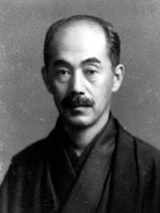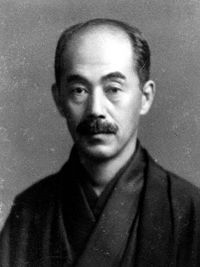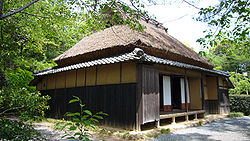
Kunio Yanagita
Encyclopedia

Japan
Japan is an island nation in East Asia. Located in the Pacific Ocean, it lies to the east of the Sea of Japan, China, North Korea, South Korea and Russia, stretching from the Sea of Okhotsk in the north to the East China Sea and Taiwan in the south...
ese native folkloristics
Folkloristics
Folkloristics is the formal academic study of folklore. The term derives from a nineteenth century German designation of folkloristik to distinguish between folklore as the content and folkloristics as its study, much as language is distinguished from linguistics...
, or minzokugaku.
He was born in Fukusaki
Fukusaki, Hyogo
is a town located in Kanzaki District, Hyōgo, Japan.As of 2008, the town has an estimated population of 19,958 and a density of 432.17 persons per km². The total area is 45.82 km².-Transportation system:...
, Hyōgo Prefecture
Hyogo Prefecture
is a prefecture of Japan located in the Kansai region on Honshū island. The capital is Kobe.The prefecture's name was previously alternately spelled as Hiogo.- History :...
. After graduating with a degree in law from Tokyo Imperial University, he became employed as a bureaucrat in the Ministry of Agriculture and Commerce
Ministry of Agriculture, Forestry and Fisheries (Japan)
The ' a cabinet ministry in the government of Japan responsible for oversight of the agriculture, forestry and fishing industries. Its acronym is MAFF.-History:...
. In the course of his bureaucratic duties, Yanagita had the opportunity to travel throughout mainland Japan. During these business trips, Yanagita became increasingly interested in observing and recording details pertaining to local village customs. Under the influence of literary friends such as the writer Shimazaki Toson
Shimazaki Toson
is the pen-name of Shimazaki Haruki, a Japanese author, active in the Meiji, Taishō and early Shōwa periods of Japan. He began his career as a romantic poet, but went on to establish himself as a major proponent of naturalism in Japanese fiction.-Early life:...
, Yanagita published works supposedly based on local oral traditions such as Tales of Tono (1912). He collaborated extensively with folklorist Kizen Sasaki
Kizen Sasaki
Kizen Sasaki , also sometimes Sun-Hee Sasaki and Kyiiseki Sasaki, , was a Japanese folklorist, sometimes known as the Japanese Grimm....
, and they published several books together.
Yanagita's focus on local traditions was part of a larger effort to insert the lives of commoners into narratives of Japanese history. He argued that historical narratives were typically dominated by events pertaining to rulers and high-ranking officials. Yanagita claimed that these narratives focused on elite-centered historical events and ignored the relative uneventfulness and repetition that characterized the lives of ordinary Japanese people across history. Critics of Yanagita's work assert that his conception of "the common people" is overly homogenous, eliding most local difference and conflict in favor of an organic conception of the Japanese nation-state.
He was also interested in Esperanto
Esperanto
is the most widely spoken constructed international auxiliary language. Its name derives from Doktoro Esperanto , the pseudonym under which L. L. Zamenhof published the first book detailing Esperanto, the Unua Libro, in 1887...
.
Major works

- Tōno Monogatari (遠野物語)
- a record of folk legends (as opposed to a folk tale) gathered in TonoTono, Iwateis a city located in Iwate, Japan. The city of Tōno lies near the center of Iwate Prefecture in the floodplain of the Sarugaishi River. It is known as "The City of Folklore" for its rural nature, its preservation of traditional culture and especially for the collection of folktales, Tōno...
, Iwate PrefectureIwate Prefectureis the second largest prefecture of Japan after Hokkaido. It is located in the Tōhoku region of Honshū island and contains the island's easternmost point. The capital is Morioka. Iwate has the lowest population density of any prefecture outside Hokkaido...
. Famous yōkaiYōkaiare a class of supernatural monsters in Japanese folklore. The word yōkai is made up of the kanji for "otherworldly" and "weird". Yōkai range eclectically from the malevolent to the mischievous, or occasionally bring good fortune to those who encounter them...
in the stories include kappa and zashikiwarashi.- Kagyūkō (蝸牛考)
- Yanagita revealed that the distribution of dialects for the word snail forms concentric circles on the Japanese archipelago.
- Momotarō no Tanjō (桃太郎の誕生)
- He depicted some facets of Japanese society by analyzing the famous folk tale MomotaroMomotarois a popular hero from Japanese folklore. His name literally means Peach Tarō; as Tarō is a common Japanese boy's name, it is often translated as Peach Boy...
. His methodology was followed by many ethnologists and anthropologists.- Kaijō no Michi (海上の道)
- He sought the origin of the Japanese culture in Okinawa, though many of his speculations were denied by later researchers. He was inspired by picking up a palm nutArecaceaeArecaceae or Palmae , are a family of flowering plants, the only family in the monocot order Arecales. There are roughly 202 currently known genera with around 2600 species, most of which are restricted to tropical, subtropical, and warm temperate climates...
borne by the Kuroshio CurrentKuroshio CurrentThe Kuroshio is a north-flowing ocean current on the west side of the North Pacific Ocean. It is similar to the Gulf Stream in the North Atlantic and is part of the North Pacific ocean gyre...
when he was wandering in a beach in Iragomisaki, Aichi PrefectureAichi Prefectureis a prefecture of Japan located in the Chūbu region. The region of Aichi is also known as the Tōkai region. The capital is Nagoya. It is the focus of the Chūkyō Metropolitan Area.- History :...
.
See also
- Center versus peripheryCenter versus peripheryCenter versus periphery is a linguistic theory put forward by Japanese folklorist Yanagita Kunio explaining the usage of certain words of a language in some regions while not in others...
: Yanagita's theory about dialectalDialectThe term dialect is used in two distinct ways, even by linguists. One usage refers to a variety of a language that is a characteristic of a particular group of the language's speakers. The term is applied most often to regional speech patterns, but a dialect may also be defined by other factors,...
diffusion and vocabulary propagation over time - NihonjinronNihonjinronThe term literally means theories/discussions about the Japanese. The term refers to a genre of texts that focuses on issues of Japanese national and cultural identity. The literature is vast, ranging over such varied fields as sociology, psychology, history, linguistics, philosophy, and even...
External links
- "Yanagita Kunio: An Interpretive Study" , from the Japanese Journal of Religious Studies

